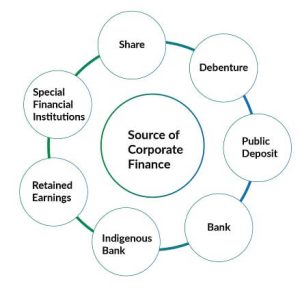The field of corporate finance is incredibly deep and sophisticated. Corporate finance’s primary objective is to increase the firm’s value to its shareholders, but it also includes other crucial choices like investment and dividend selections. A business may effectively manage its current financial situation and create plans and budgets for the future by applying knowledge and planning in the right way.
Shares, Debentures, Public Deposits, Banks, Indigenous Banks, Retained Earnings, and Special Financial Institutions are only a few examples of the many sources of corporate finance. A business will succeed if it manages its funds effectively.


Trade Finance
Trade finance refers to the financial support offered for trading transactions both domestically and abroad through a variety of financial instruments. Trade finance is simply the money and assistance offered to carry out business transactions. Banks and other financial institutions are primarily responsible for approving trade finance and play a key role in overall corporate finance planning for businesses.
Trade Finance Types:
Loan or Working Capital Facility
Loan terms
Credit Letter
Discounting of Receivables (also known as Factoring, Discounting, and Cheque Discounting)
Bonds or Assurances
Options for Trade Finance
GSPU’strade finance advising service has real-world expertise in assisting firms with their corporate finance requirements.
- Working Capital
The gap between current assets (cash, inventory, and accounts receivable) and liabilities (accounts payable, short-term borrowing, and accrued liabilities) is known as working capital.
In other words, from the time the company purchases raw materials until it receives payment from sales of its products and pays its suppliers, it is crucial to understand the operating cycle from raw material and inventory acquisition through supplier payment. For the examination of working capital, the number of days required for this conversion cycle is crucial. The finance team may identify the working capital shortfall based on this research and plan to source the funding to close it, which is an important part of corporate finance management.
- Loan terms
A term loan is an advance from the bank that must be paid back over a predetermined number of instalments. Along with the fixed instalment, term loans require a rate of interest that is either fixed or changing. Term loans are typically used by businesses to buy fixed assets. According to the length of the loan, term loans can be divided into three categories: short-term loans, intermediate-term loans, and long-term loans. Collateral may also be needed for a term loan to lower the risk of a payment default. Such loans are a crucial component of corporate finance for business expansion.
- Credit Letter
Documentary credit, often known as a letter of credit (LC), is an irrevocable commitment made by a bank to pay a beneficiary if the beneficiary presents the required documents and the LC’s terms and conditions are met. Due to variables like distance and ambiguity about a party’s sincerity, the Exporter and Importer in international trade use an intermediary such as a bank to guarantee the payments and delivery of goods. If the buyer is unable to pay, the bank will be obligated to cover the entire sum.
Credit Letter’s advantages
To the buyer
- Facility not reliant on funds
- Option for financing without interest
To the seller
- Reduces the credit risk
- Utilize pre-shipment financing based on the LC.
- Timely money receipt
Discounting of receivables
Discounting of invoices: Discounting of invoices enables a firm to collect a portion of the increased invoice amount upon presentation of the invoice and the remaining portion upon receipt of the customer’s payment. The ability to quickly receive funds through invoice discounting will improve the company’s cash flow. This facility is often customer-specific and under the Bank’s agreement with the customer. Before discounting an invoice, the bank will consider the clients’ ability to pay, the borrower’s creditworthiness, and additional security.
Cheque discounting: A facility offered by the bank entails financing the transaction and supplying monies in advance of the due date of a PDC issued by a client. With this agreement, the provider receives the money right away, giving the customer a grace period to pay.
Bonds or Assurances
Bonds or guarantees are services provided by a bank that gives the buyer security if the seller is unable to fulfil the commitment. When the seller fails to deliver the ordered items, the customer is compensated by the bank. These are primarily utilized for specific projects or in the construction industry. Tender Bond, Performance Bond, Advance Payment Bond, Retention Bond, and Payment Guarantee are some examples of the various bonds or guarantees based on “on-demand” and “conditional” classes.
- Hurdle Rate Comparison
Compares the numerous projects according to the degree of situational complexity and determines the best plan of action for each of the listed projects to take advantage of their limitations.
- Make a decision.
A company’s ability to make sound financial decisions is aided by corporate finance. To aid in the expansion of the firm, the chosen course of action is carried out and the appropriate control measures are implemented.
- Create a financial strategy.
Corporate finance assists in developing a financial strategy based on organizational requirements and aids in a company’s pursuit of the highest level of profit.
- Improve Relationships
Corporate finance facilitates the relationship that already exists between stockholders and management and ensures that there is no hostility between them.
- Identify the Future
Determining corrective actions serve as a roadmap for the business to follow and aids in its continued growth shortly.
- Helps to save on taxes
By giving the business entity a clear perspective of the books of accounts, it paves the door for tax savings, enabling your company to expand.

By obtaining the financial support needed to carry out the commercial operations of a trading company from banks and other financial institutions, Trade Finance will assist the company in expanding. Businesses that lack the working capital or cash flow to meet their needs will be helped by trade finance. Trade Finance will, to some extent, provide relief from cash shortages, prolonged customer credit terms, and blocked payments on unsold stocks.
By assuring assured payment to the suppliers on time, depending on specific pre-agreed conditions, trade finance will assist a business in offering more competitive pricing and terms to the Suppliers and Customers.
Offering choices like Terms Loan, Overdraft, Customer Invoice Discounting, etc., will also assist the business in overcoming cash flow problems or liquidity gaps. Trade Finance will allow companies to buy merchandise in large quantities, allowing them to negotiate and receive high-quantity discounts that will boost their profitability. Due to the payment risk being as little as possible thanks to trade finance, the business is also better able to forge solid relationships with its suppliers and clients.